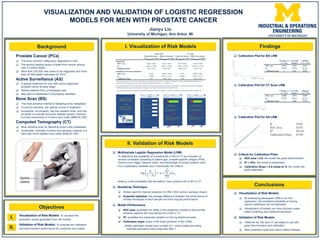
POSTER_JIANYU_LIU
- 1. The most common malignancy diagnosed in men The second leading cause of death from cancer among men in United States More than 230,000 new cases to be diagnosed and more than 30,000 deaths estimated for 2013 A special treatment for men with newly-diagnosed prostate cancer at early stage Relieve patients from unnecessary pain May lead to metathesis if not properly identified The most sensitive method of detecting bone metastasis Crucial for deciding the optimal course of treatment Accessible, noninvasive, has low radiation dose, and has an ability to evaluate the entire skeletal system; however it is time-consuming (3-4 hours) and costly ($600-$1,000) Most sensitive scan for detecting lymph node metastasis Accessible, minimally invasive and painless; however it is risky with more radiation and costly ($300-$1,500) To visualize the prediction results generated from risk models To evaluate the calibration and discrimination performance for predictive risk models I. Jianyu Liu University of Michigan, Ann Arbor, MI To determine the probability of a positive AS or BS or CT as a function of several covariates consisting of patient age, prostate-specific antigen (PSA), clinical tumor stage, Gleason score, and percentage of biopsy positive cores. For k explanatory variables and n individuals, the LRM is: log 𝑝𝑖 1 − 𝑝𝑖 = 𝛼 + 𝑗=1 𝑘 𝛽𝑗 𝑥𝑖𝑗 where pi is the probability that the patient i has a positive AS or BS or CT Widely used for internal validation of LRM (1000 random samples drawn) Expected optimism: the average difference between the performance of models developed in each sample and their original performance ROC area: quantifies the ability of the prediction models to discriminate between patients with and without AS or BS or CT R2: quantifies the explained variation on the log-likelihood scale Calibration slope: slope of the linear predictor of the LRMs Well-calibrated models have a slope of 1, while models providing extreme predictions have slope less than 1 ROC area > 0.8: the model has great discrimination R2 > 30%: the model is explanatory Calibration Slope > 0.9 (close to 1): the model has great calibration By embodying developed LRMs in an iOS application, the predicted probability of having cancer metathesis can be estimated Visualization of models can help clinicians make better screening and treatment decisions LRMs for AS, BS, and CT are stable to use with great discrimination and calibration Save treatment costs and extend patient lifespan II. ROC area 0.888 0.873 0.855 R2 43.5% 38.6% 32.1% Calibration slope 1 0.88 0.938 Training set (n =643) Internally validated Validation set (n =507) ROC area 0.844 0.822 0.811 R2 34.0% 27.6% 29.4% Calibration slope 1 0.83 0.962 Internally validated Training set (n =416) Validation set (n =664) Optimisimb ROC area 0.022 ± 0.031 0.031 ± 0.013 0.015 ±0.021 0.014 ± 0.028 R2 6.44% ± 7.90% 4.82% ± 2.03% 4.90% ± 6.0% 10.34% ± 2.21% Shrinkage factor 0.83 ± 0.22 0.80 ± 0.23 0.88 ± 0.14 0.92 ± 0.16 Optimism-corrected performancec ROC area 0.822 0.802 ± 0.014 0.873 0.863 ± 0.031 R2 27.60% 25.7% ± 4.7% 38.60% 30.1% ± 4.5% Calibration slope 0.83 0.80 ± 0.23 0.88 0.92 ± 0.16 a Expected performance was based on training datasets, and observed performance was based on validation sets. Means and empirical standard errors are shown. 1000 bootstrap samples were used for calculation of the means and SETraining , and SEValidation. b The expected optimism was calculated as the difference between bootstrap performance and test performance. The observed optimism was calculated as the difference between apparent performance in training sets and observed performance in the validation sets. c The optimism-corrected performance was defined as apparent performance - optimism. The observed optimism-corrected performance is equal to the oberserved performance in validation sets. Bone Scan CT Scan Expected, mean ± SETraining (n= 416) Observed, mean ± SEValidation (n= 664) Expected, mean ± SETraining (n= 643) Observed, mean ± SEValidation (n=507)
